Lambert here: Impressive reporting from DeSmog on conditions at a Harkonnen enclave in Ohio.
By Justin Nobel, who writes on issues of science and the environment for Rolling Stone and has a book on oil and gas radioactivity forthcoming with Simon & Schuster entitled PETROLEUM-238: Big Oil’s Dangerous Secret and the Grassroots Fight to Stop It. Originally published at DeSmog.
Activists and scientists have found alarming levels of radioactivity in samples collected along the road and soils outside Austin Master Services, an oilfield waste processing facility with a history of sloppy practices in eastern Ohio. The facility is located just down the street from a high school football stadium and less than 1,000 feet from a set of city drinking water wells, raising public health concerns from a nuclear forensics scientist about the extent of possible radioactive contamination.
Last November, members of two advocacy groups, Concerned Ohio River Residents and Mountain Watershed Association, collected soil samples from outside the Martins Ferry, Ohio facility of Austin Master Services, a Pottstown, Pennsylvania-based company that operates in 10 states. Both groups are concerned about the handling of radioactive oilfield waste in their region, which has seen over a decade of intensive fracking development in the Marcellus and Utica shale formations.
All of that oil and gas drilling produces huge volumes of liquid and solid waste that need treatment and disposal. Oilfield waste service companies pick it up directly at the wellhead, and sometimes perform an initial processing, before bringing some of it to facilities like Austin Master’s for additional treatment. But how well-prepared such companies are to handle the industry’s radioactive waste is being increasingly called into question. For instance, a DeSmog investigation has revealed that railcars carrying radioactive oilfield waste from Austin Master in Martins Ferry have arrived leaking at a final disposal facility in Utah on multiple occasions between 2015 and 2020. Over the years, conditions at Austin Master have raised concerns from inspectors and advocacy groups alike.
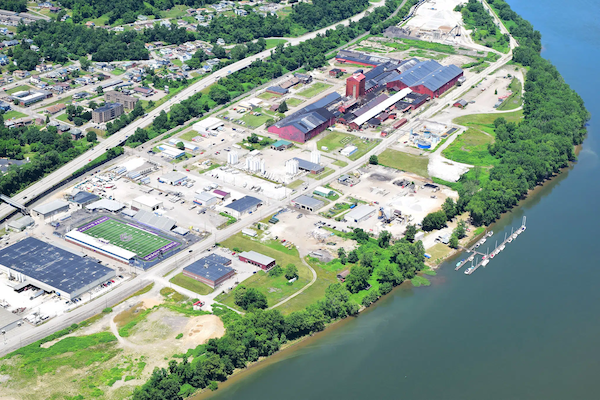
James Cato, with the southwestern Pennsylvania-based environmental advocacy group, Mountain Watershed Association, recalls the day he and other volunteers first took soil samples on the public roadway near the Ohio oilfield waste facility.
“It was a bright cloudless morning but the dirt road to Austin Masters was hazy with dust stirred up from truck traffic,” says Cato. “Between [Austin Master] and the nearby asphalt plant, a sour scent clung to everything and dust buffeted our goggles and protective masks whenever a waste truck blew by.” He added that their radiation detector’s activity was especially notable in this location, emitting “near constant rapid beeping.”
The Ohio and Pennsylvania advocacy groups sent the Austin Master samples to Marco Kaltofen, a nuclear forensics scientist in Massachusetts who has extensive experience examining radioactive waste from the nuclear weapons, nuclear power generation, and oil and gas industries. Before the activists gathered the samples, Kaltofen advised them on appropriately handling and shipping the potentially radioactive samples. After reviewing them, he then sent the samples to Eberline Analytical, a radiological analysis lab in Oak Ridge, Tennessee.
The relatively high levels of radioactivity in the results, returned in February, immediately caught Kaltofen’s attention. “This needs to be fixed,” he says. They found levels of radium-226 at 14.1 picocuries per gram, and radium-228 at 3.7 picocuries per gram.
Radium is one of several naturally occurring radioactive elements well-known to occur in oilfield waste. Soil nationwide generally has a radium background level of about 1 picocurie per gram, and the U.S. Environmental Protection Agency (EPA) limit for topsoil at uranium mills and Superfund toxic waste dumps is 5 picocuries per gram above background levels. The samples analyzed by Eberline also showed elevated levels of radioactive forms of lead and thorium.
“This is an impressive source of contamination. These numbers are well above background and excessive,” says Kaltofen. “I have very grave concern about the accidental inhalation and ingestion of these particles. My concern here is wind is going to move this out into the neighborhood.” The radioactive dust and soil may settle in yards where children play, he says, and kids tend to dig around in grass and dirt, and then touch their fingers to their mouths.
This is especially worrisome, according to Kaltofen, because radium is considered a “bone-seeker.” If accidentally inhaled or ingested, the radioactive element tends to accumulate in the bones, where it continues emitting radiation and can lead to cancer. “Radium 226 is a potent source of radiation exposure, both internal and external,” notes a 1982 report that discusses oilfield radioactivity hazards and was produced by the American Petroleum Institute’s Department of Medicine and Biology’s Committee for Environmental Biology and Community Health.
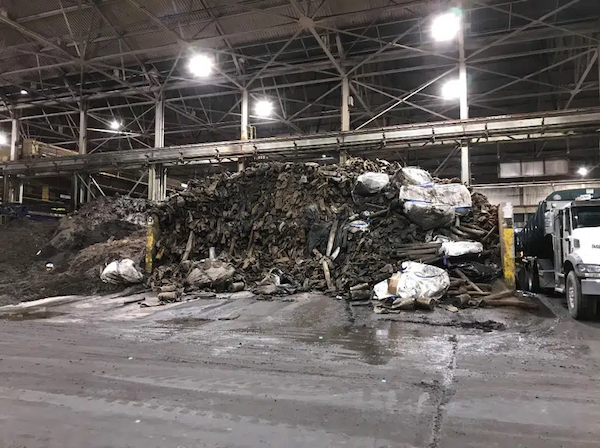
Although the EPA does not regulate oilfield radioactivity, it does have a web page with information on the topic. “Maintenance workers include those who work directly on top of uncovered waste sites,” the EPA page states. “Potential risks assessed for these workers include inhalation of radioactive dust.” Risks for members of the public working or residing within roughly 100 yards of a disposal site are very low, continues EPA, but include, “Inhalation of contaminated dust,” “Ingestion of contaminated well water,” “Ingestion of food contaminated by well water,” and “Ingestion of food contaminated by dust deposition.”
Kaltofen explained that any time oilfield waste is moved around in piles at a processing facility such as Austin Master, dust is inevitably created. Even if the waste is wet, it will eventually dry and create dust, and this dust would invariably have some of the radioactive elements common to oilfield waste attached, such as radium. He added that the buildup of radioactive elements common to oilfield waste directly in front of a facility processing copious amounts of oilfield waste points to Austin Master as the likely source.
After receiving the initial round of concerning results near Austin Master in February, Concerned Ohio River Residents (CORR) sent the Eberline lab a second batch of samples taken along the public roadway adjacent to the Martins Ferry facility and also a nearby city park and cemetery. Results showed an increase in radioactivity closer to the facility.
For example, levels of radium-226 recorded at the park, just over a mile from the facility, and the cemetery, just over half a mile, fell around average soil background levels or just above them. But levels taken along the road to Austin Master ticked up from 3.76 picocuries per gram, about 900 feet from the facility’s main entrance, to 14.66 picocuries per gram less than 150 feet from the entrance. Based on the path of samples taken by members of CORR, a growing trail of radioactivity leads to Austin Master’s door.
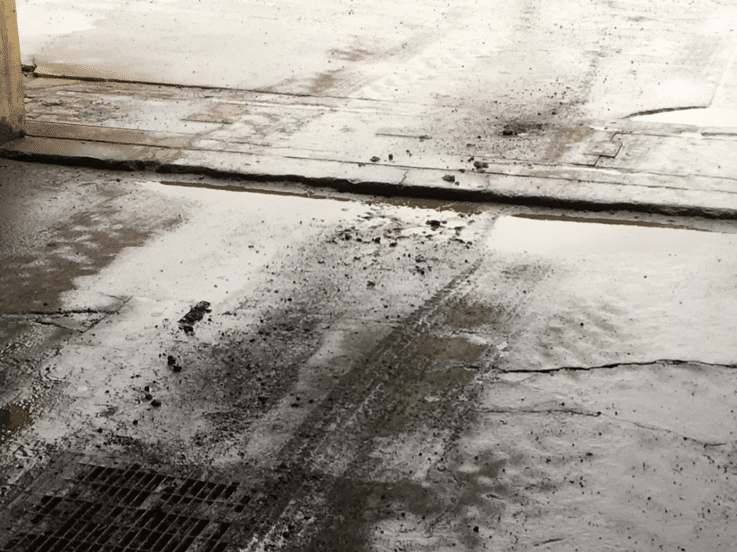
Austin Master Services has authorization with the state of Ohio to annually receive 120 million pounds of radioactive oilfield waste. Despite the dangers this type of waste poses, a 1980 federal exemption has deemed it to be non-hazardous and therefore exempt from federal rules that would otherwise apply to hazardous waste.
On April 4, Concerned Ohio River Residents held a press event in Martins Ferry and demanded that state officials issue orders to immediately stop work at the Austin Master facility due to public health and environmental concerns. The group also requested that the EPA perform an inspection of the entire facility, and has said it will push for the plant to become a Superfund site, an official designation reserved for massively contaminated lands and environmental emergencies that would make funds available for cleanup. EPA has not replied to questions regarding these requests.
“We want them to invoke their law and do their own testing of the whole entire area,” Beverly Reed, an Ohio Valley business owner and member of Concerned Ohio River Residents, stated at the press event.
We want the site cleaned up and properly monitored, Reed continued, before the situation becomes “a crisis.”
Chris Martin, a spokesperson for Austin Master, has not replied to a request for comment regarding Concerned Ohio River Residents’ sampling results.
Oilfield Waste: A Long Arc of Documented Contamination in Fracking Country
Oil and gas development generates several voluminous waste streams, both liquid and solid. The radioactive signature of oilfield waste has been acknowledged by the oil and gas industry for decades, well before the advent of modern fracking in the 1990s and early 2000s. And research by the U.S. Geological Survey indicates that oilfield waste generated in the Marcellus and Utica has particularly high radioactivity levels, leading to “the potential for surface and aqueous radium hazards if not properly disposed of.”
The processing of radioactive oilfield waste has proved enormously problematic for the oil and gas industry and its regulators, and given rise to a booming service sector of facilities like those run by Austin Master that collect, treat, and process the waste. Part of the problem is that a significant amount of oilfield waste is too radioactive to be shipped directly to traditional landfills. Instead, it must be “down-blended,” or mixed with material like lime or a corn cob base to lower the radioactive signature.
Waste with low radioactivity levels can then be shipped to local landfills, while more radioactive waste must be shipped to secure disposal facilities out West. The practice is poorly regulated and leaves room for considerable operator error and potential malfeasance.
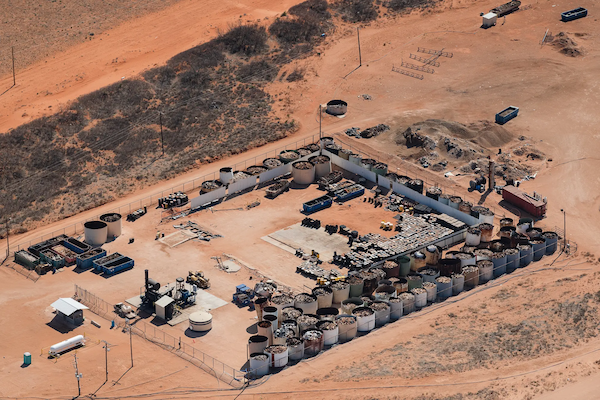
In February 2021, DeSmog reported on a West Virginia facility processing radioactive oilfield waste that went up in flames, and in April 2021, DeSmog reported on a radioactive oilfield waste disposal facility in West Texas repeatedly flagged by state regulators for its inappropriate disposal practices.
A 2018 EPA report on oilfield waste treatment centers in Pennsylvania, Ohio, and West Virginia found expired permits and ill-prepared operators at some facilities. Furthermore, it uncovered elevated levels of heavy metals and radioactive substances in the environment near the facilities, raising the concern of “potential impacts to both aquatic life and human health.”
But due in part to oil and gas’s federal exemption from its waste being labeled “hazardous,” it receives a monumental pass on regulations. EPA spokesperson Enesta Jones tells DeSmog, “EPA does not regulate radioactivity in oil and gas production, processing and transport systems.” Jones pointed to state agencies as having the authority to track and regulate oil and gas waste and its radioactivity.
Yet local and national environmental groups have been increasingly critical of the ability of oil and gas states across the country to appropriately regulate the oilfield waste industry.
“Industry is reaping the benefits of having so many places and ways to cheaply dispose of its waste, and communities are bearing the burden of that cheap disposal,” says Megan Hunter, a senior attorney with Earthjustice, a national environmental nonprofit closely tracking oilfield waste contamination in the Ohio River Valley region.
“Waste Falling Off the Truck”
The Ohio Department of Natural Resources (ODNR) does regulate the state’s roughly two dozen oilfield waste processing facilities, but in a limited way. In 2014, Austin Master received an ODNR order, known as a Chief’s Order, giving the company temporary approval to “process, recycle, and treat brine” and other oilfield waste. According to this regulatory document, the waste is to be “tested for radiological concentration of Radium 226 and Radium 228 prior to processing and packaging,” and then shipped to “an appropriate disposal facility” by truck or railcar.
ODNR does inspect such “Chief’s Order” facilities, and these reports provide a trail of documents showing just how radioactive waste has been allowed to spill out of the facility. For example, on September 7, 2018, the inspector noticed “one blue frac tank being removed from the facility onto the public roadway and waste was falling off the truck.” Austin Master staff were “outside cleaning up the parking lot and public roadway with a bobcat and brush.”
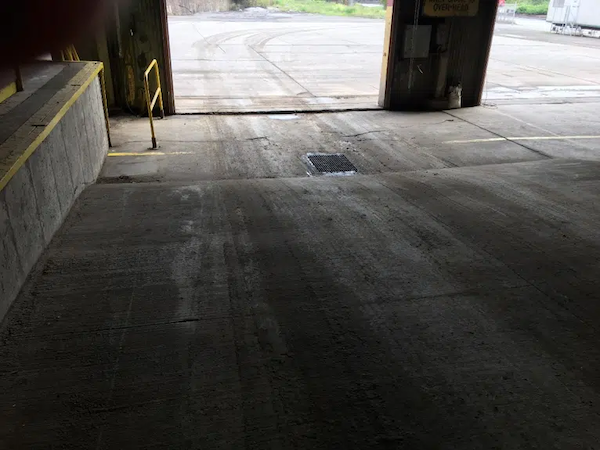
In an earlier visit on February 22, 2018, inspectors observed waste “splattered on the floor,” “splashed onto the warehouse wall,” and also “in the proximity of the electrical panels.” The Austin Master facility also has had a persistently leaky roof. Over the years, the state’s inspectors have warned that this “increases the opportunity for the waste to be tracked from the warehouse and is a hazard for the workers” and lamented the ongoing issue of “tracking of waste outside of the building.”
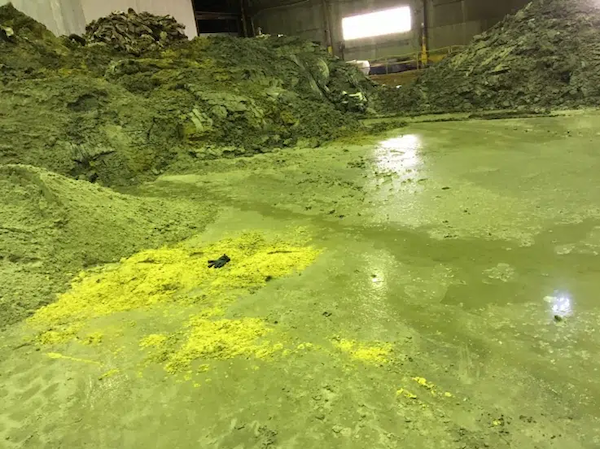
State regulators have documented waste at relatively high radioactivity levels being prepared for transport out of the facility. On February 12, 2019, inspectors with the Ohio Department of Health noted that radiation levels on “a large ‘burrito’ bag of waste” waiting to be loaded into a railcar measured 73 times the facility’s background levels. Radioactivity levels more than twice the background are “positive indication of contamination, and should be handled as such,” according to a 2016 report of the International Association of Oil & Gas Producers.
Furthermore, three inspections in 2017 all state, “Austin Masters is currently operating outside of the approved application documents, that constitute the authorization included in the Chief’s Order.”
Despite these repeated transgressions, Stephanie O’Grady, an ODNR spokesperson, says, “The Division does not have the authority to levy fines, none the less, the Division strives to ensure regulated entities are complying with Chief’s Orders, Ohio law and rule.” While after September 2018 some inspection reports note improvements at the plant, others continue to detail alarming practices.
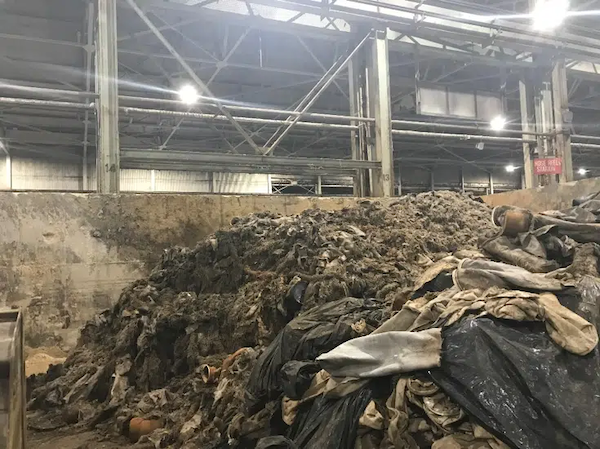
One of the more radioactive and problematic streams of waste the oil and gas industry produces are known as “filter socks.” These long thin mesh bags filter sediment at injection wells, where oilfield waste is injected deep into the earth for long-term disposal. At Austin Master’s Martins Ferry facility, Ohio inspectors learned that filter socks were being put through “a tree shredder,” and during another visit, torn apart by a piece of processing equipment called a “Muffin Monster.”
“The problem here is that workers will inhale or ingest the cloud of radioactive dusts created by the tree shredder,” says Kaltofen, the nuclear forensics scientist. “Even if wet, the spatter from the shredder must eventually dry, creating a breathing hazard. Wet spatter from the shredder can coat the clothing and exposed skin of workers, exposing them to radium hazards. Workers’ skin can also become coated with this radioactive material, and either absorb it, or contaminate their families.”
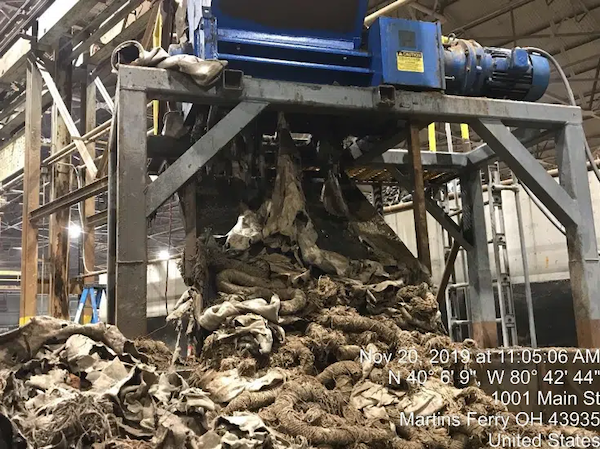
Wilma Subra, a Louisiana toxicologist whose work assessing community contamination from radioactive oilfield waste helped earn her the prestigious “MacArthur Genius Grant”, in 1999, says that oilfield workers carrying contamination home to their families has been well documented. She cites an example in which one man the state of Louisiana tested had radioactivity all over his clothes, his car, his front steps, and even on his newborn baby.
“There is nothing unusual or harmful about AMS’s process,” says Chris Martin, a company spokesperson, in response to questions about the company’s practices. “Austin Master Services takes a responsible approach to providing valuable waste remediation services and jobs in the Martins Ferry community.”
This past January, new rules governing Ohio’s oil and gas waste facilities took effect, and operators will have six months to come into compliance. However, observers note that these rules may not address concerns about how close these facilities are to communities and drinking water sources.
“They have new siting criteria, which is good, but it won’t apply to existing facilities, and it is waivable for the new facilities,” says Hunter, the Earthjustice attorney. “So, there is a lot of room for discretion.”
Leaky Railcars of Radioactive Oilfield Waste Crossing the United States
From March 2015 through March 2020, more than 76 million pounds of oilfield waste, too radioactive to end up in local landfills, were shipped in railcars from Austin Master’s Ohio facility across the country to a disposal site in Utah. According to files provided to DeSmog by EnergySolutions, those shipments were discovered to be leaking on five occasions. This desert destination, a disposal facility operated by EnergySolutions, accepts radioactive waste from the nuclear power generation and medical industries, and to a lesser extent, the type originating at oil and gas drilling sites and handled by Austin Master.
In response to questioning from DeSmog regarding the rail car leaks, Tim Orton, EnergySolutions director of technical services, says, “There is a potential that the waste had leaked all the way across the country,” but his company analyzed the spilled waste in each instance and “did not find any radioactivity in any of [the] spilled liquid.”
He blames the leaky railcars that arrived at his facility on the operator that initially loaded them with radioactive waste.
“If the waste is managed correctly on the shipping end (ensuring the moisture content is low enough to not come out during transport; having good liners within the railcars, proper inspection of the railcars, etc.) there shouldn’t be any issues when the waste arrives at our facility,” says Orton in an email. “When you consider the entirety of shipments sent (390), the amount of leaking shipments was minimal (<5%).”
On other occasions shipments arrived from Austin Master to EnergySolutions’ Utah facility without manifests, with ripped liners, and with “torn load wrappers.”
Orton says, “the waste was transported by CSX Transportation and arrived on the Union Pacific rail line.”
“Under the interstate commerce laws, CSX, as a railroad, is a common carrier that is required to transport any commodity, including hazardous materials, tendered to us,” stated a CSX spokesperson. “The CSX chemical safety and hazardous materials teams work closely with customers, first responders and local communities to manage the safe movement of hazardous materials on our rail network and to protect the public in the event of unexpected incidents. We have not had a documented release of product associated with Austin Master Services as the shipper, so we have had no reason to perform any testing for product release along the CSX owned rail corridor.”
As the trains carrying this radioactive waste cross the country from Ohio to Utah, they travel through the U.S. heartland, with Kansas smack in the middle of the most direct route. “Reports of potentially radioactive fracking waste impacting Kansas residents should be treated with utmost urgency and concern from our state and federal regulators,” says Ty Gorman, a Sierra Club representative in Kansas. “The stakes are too high for this pattern of seeming negligence to continue.”
Orton, with EnergySolutions, has also provided information that raises a new concern.
He says that Austin Master’s contract with EnergySolutions expired on February 28, 2020, and has not been resumed.
This raises the question: where has all of Austin Master’s more highly radioactive oilfield waste been going since that date, and where is it presently going?
Austin Master has not provided an answer to this question. ODNR said the agency does not keep track of where waste goes once it leaves the Austin Master facility in Martins Ferry.
“We do not collect information regarding waste disposal manifests from oil and gas waste facilities,” stated O’Grady, the ODNR spokesperson. “The location for waste disposal is a business practice, overseen by the proprietors of the facility. As a regulatory agency, our job is to ensure that the Austin Masters facility is operating in accordance with the chief’s order that they have been granted. That chief’s order does not permit them to dispose of oilfield waste at the facility. We perform regular inspections at Austin Masters to ensure they continue to operate in compliance with the terms of that order, and there have been no waste-disposal violations during any inspections since February 28, 2020.”
Looking for Answers
DeSmog sent Austin Master a detailed list of questions regarding waste management practices, worker safety measures, and the ultimate destination of the waste the facility processes. DeSmog specifically informed Austin Master that ODNR inspection reports show continual releases of waste into the environment beyond the Martins Ferry facility and asked, “What if anything has Austin Master done to mitigate these releases and alter these practices?”
Chris Martin, who runs a public relations and marketing communications firm called Atlas Marketing, and says he speaks for Austin Master, defended the company and its practices as responsible and typical of the industry. “Like many local wastewater treatment facilities, AMS remediates wet waste that arrives at our facility. Our process utilizes a hydraulic press that facilitates the capture and treatment of water within a self contained wastewater treatment system. Ultimately, the remediated waste materials are dewatered and removed from the facility.”
“Unfortunately, AMS has been targeted and scapegoated with blatant misinformation and illegitimate claims,” Martin added. “Particularly because AMS is one of the smaller businesses in its industry, these reckless and inflammatory fabrications have only served to create an unjust advantage for AMS’s competitors and larger companies in the industry, which ultimately harms AMS’s employees and the local economy of Martins Ferry. AMS is dedicated to the safety of our employees and our community. Further, there are no known complaints from AMS employees concerning work conditions.”
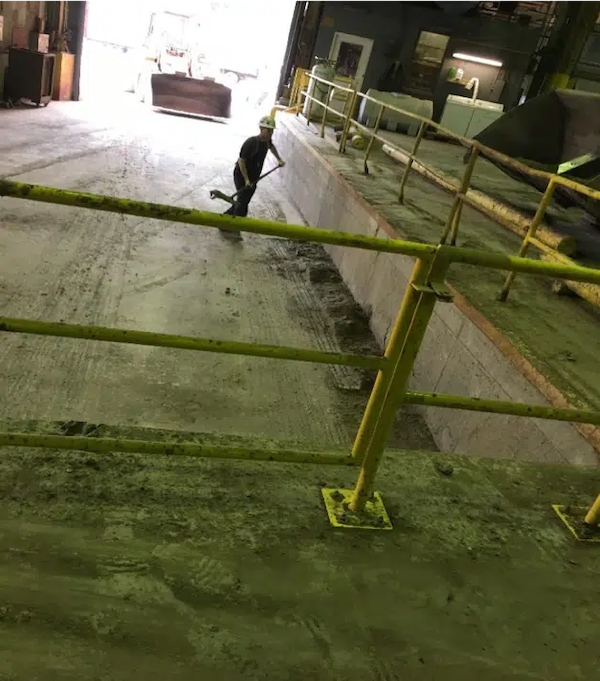
DeSmog requested to speak with a current Austin Master employee but this request was rejected by Martin. He has not replied to questions by DeSmog concerning what specific “competitors” and “larger companies in the industry” he was referring to.
Local, state, and federal agencies have had little to say about the elevated levels of radioactivity found outside the Martins Ferry waste facility and activists worry their concerns are not being acted upon. Questions sent to the City of Martins Ferry regarding the Austin Master facility and the community’s drinking water supply returned the following reply: “I am receipt [sic] of your email below and have forwarded a copy of this request to our legal counsel.” But despite repeated requests, no additional comments have been provided.
DeSmog forwarded documents containing the results of Concerned Ohio River Residents’ sampling efforts to the EPA, ODNR, and Ohio Department of Health. “The Division has received the correspondence from the Concerned Ohio River Residents (CORR) and is reviewing it,” said O’Grady, the ODNR spokesperson. “It would be inappropriate for the Division to comment until this review is complete.”
“We are unable to comment on an outside group’s data because we cannot do quality assurance on the results,” stated EPA strategic communications advisor Taylor Gillespie.
The Ohio Department of Health has not yet replied. Martins Ferry City Schools, the City of Martins Ferry, and Austin Master Services have not replied to this same request.
“We have a real problem at this site and citizens had to do the environmental testing with our own time and money,” says Beverly Reed, of Concerned Ohio River Residents, and a member of both of the Austin Master sampling efforts. “We want the state agencies to take notice and listen to our list of demands and we also insist that our elected officials get involved. They should be putting citizens ahead of all else.”
<
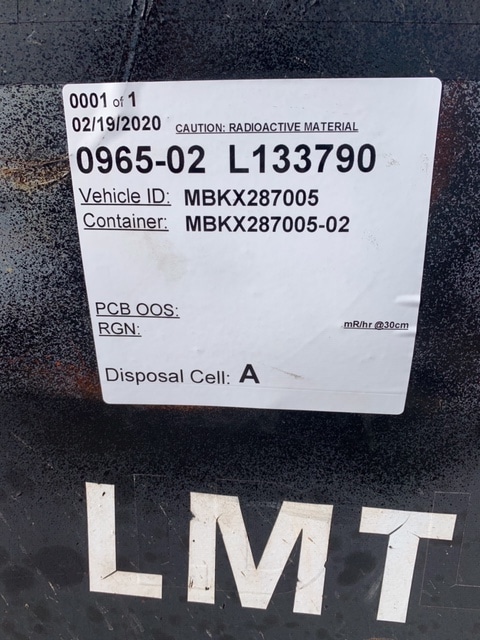
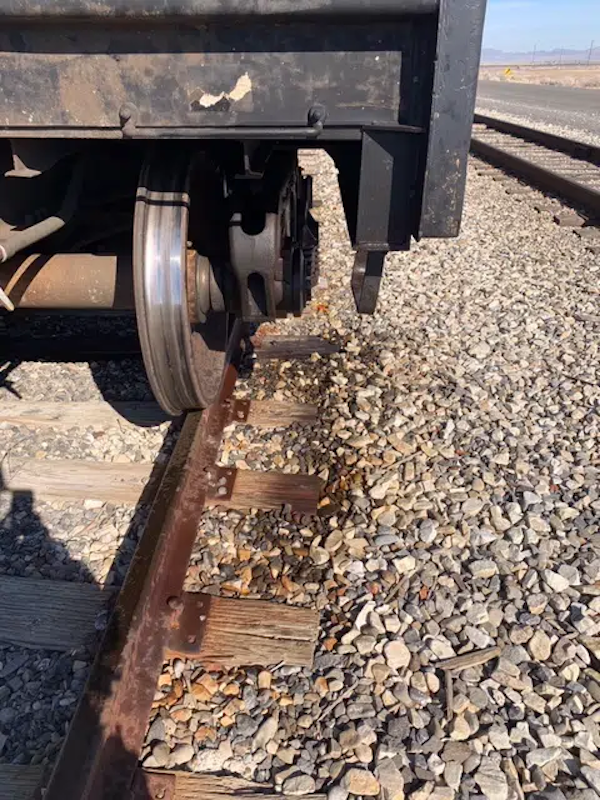


Lambert, some of the material in this very long article appears to have been repeated several times.
Thanks. I redid the whole piece. Somewhere in my workflow there’s intermittent drag-and-drop functionality that “helps me,” and occasionally I end up with duplicated material. Never been able to run down.
We’d interviewed a dying 40yr old female EPA inspector, in East Liverpool, OH (after taping Martin Sheen and others, arrest for trespass at a Swiss Toxic Waste Incinerator; Hillary’s firm went after us). The central division conveniently ends at the Ohio, so it’s BEEN Cancer Valley for quite a while). I’d thought it HILARIOUS, that NewYorker got around to reporting PA kids dying from obscure blood cancers & predisposition to ARDS & cytokine storm, as COVID-19 hit. Readers just might remember how, Hillary’s loss triggered a blame the victim tsunami over morbidity/ mortality of death o’ disparity drug abusing deplorables (who really don’t fit the Creative Class’ facile stereotype as to race, sex, age. The inspector had been exposed to so many different toxins, it was terrifying to put her theough the taping, just knowing NOBODY in Pittsburgh, Wheeling or Youngstown would DARE show any interest. We’d become inured to “sacrifice zones” well before slick water fracking, ethane cracking. Shell’s 97 mile wet-gas/ liquids pipeline, basically uninspected & leaking everywhere, is TOTALLY uncovered, poisoning local streams & aquifers. The two lines that blew up weeks after installation & XTO blow-out (that spewed more methane in 19 days, than EU energy production causes in a year) are status quo, now. Biden picked this war with Russia to bail-out “our” party’s fracked LNG/ oil export Ponzi Scheme and the victims’ HAD no say, we’d LOTE it all away!
ZERO compliance if no appropriate penalties for violations. Suggestion: $5MM for the first violation, $10MM for the second, and business shutdown upon 3rd violation. Fair to me and I would bet very effective if they stick to these penalties and enforce them immediately.
Adding fracking oil waste to the existing coal ash environmental hazard makes modern Nuclear energy look more and more the safest way to approximate a zero carbon world.
Until, you go to a few miles away, where they’ve been fracking within a quarter mile of two ancient ginormous reactors, right across the Ohio from the planet’s first commercial fission reactor (which, thank heavens had proper USN oversight, at FIRST!) I’d be curious, how we’ll EVER use fission with tag-team kleptocracy perfectly willing to sacrifice precariate, red-lined into Cancer Valley, Frackistan to satisfy smug petit bourgeois consumerism 400 miles away; as Catastrophe Capitalism’s become a pleonasm? Sorry, it’s NO facile solution.
The great article just talks about oil fracking but gas fracking has the same byproducts.
Thanks Obama for putting about zero regulations on fracking.
I noticed that the article is repeating itself, too. Nuclear energy has one MAJOR problem it’s sharing with the oil and gas crowd: radioactive waste. Humans still have problems safely disposing it. Radiation waste is no joke; it’s a deadly pollutant that lasts for centuries. This country has got abandoned oil drilling sites and pipelines scattered all over the place, land and sea. It’s a scary fact that needs immediate attention, but won’t get it.
Thorium has dramtically lower waste and not suitable for weapons manufacturing. Technology can make nuclear waste manageable . We could potentially send nuclear waste into the Sun via rocket. Any discussion of nuclear waste must be relative to the environmental disaster created by the use fossil fuels.
Seriously???? Rockets to the sun????
We had a far better way to dispose of lethal waste, from Shippingport?
https://foreignpolicy.com/2015/03/23/what-lies-beneath-numec-apollo-zalman-shapiro/
https://military-history.fandom.com/wiki/The_Apollo_Affair
G. Etchason: Thorium has dramtically lower waste and not suitable for weapons manufacturing.
You couldn’t be more wrong. A thorium reactor will make the best little producer of fissile uranium — and plutonium — out there when properly converted. See (in particular section starting p. 12) —
‘U-232 and the Proliferation- Resistance of U-233 in Spent Fuel’
by Jungmin Kang and Frank von Hippel (2001)
https://fissilematerials.org/library/sgs09kang.pdf‘
In fact, you can reliably get more fissile material out of the back end of a thorium reactor than you put in, because you need an initial uranium seed to start the chain reaction as thorium is fertile but not fissile.
We could potentially send nuclear waste into the Sun via rocket.
Like A. Stegman, I struggle to imagine a stupider, more dangerous ‘solution.’
orlbucfan: Nuclear energy has one MAJOR problem … radioactive waste. Humans still have problems safely disposing it. Radiation waste is no joke; it’s a deadly pollutant that lasts for centuries.
‘Radiactive waste’ is a category largely invented in the 1970s to describe the partially-spent nuclear fuel left over because the US government and the US energy industry favored the once-through nuclear fuel cycle — the US government because it wanted to prevent the proliferation of reprocessing capability and so preserve its nuclear hegemony; the US energy industry because reprocessing is much more expensive and would have cut into profits.
Nevertheless, the major nuclear threat the US faces is now the acres of partially-spent fuel in cooling pools around its reactors, unless the fools in Washington blunder into a nuclear war. Reprocessing capability cannot be de-linked from enrichment capability for building nuclear weapons, to be sure. But it’s the only sane way to do nuclear power and, in any case, the US no longer has the clout it did and the rest of the world is moving on towards reprocessing.
You explain Chernobyl to me. I’m a NASA brat, so I have a general understanding of nuclear energy, nuclear weapons, and radioactive poisoning. I’m no scientist; but my late father was who designed satellite telemetry. Granted, Chernobyl melted down in the 1980s, but the radioactive dangers remain. A lot of innocent soldiers on both sides are dying/died horrific deaths cos the ground near the entombed energy plant was stirred up. It’s similar to what this article is reporting.
You explain Chernobyl to me … A lot of innocent soldiers on both sides are dying/died horrific deaths cos the ground near the entombed energy plant was stirred up. It’s similar to what this article is reporting.
Sure. “Explain Chernobyl to me” is a glib question but I can give you a glib but true answer. (Though I’d point out that we’ve only Ukrainian propaganda, but no hard evidence whatsoever that ‘innocent soldiers’ are actually dying ‘horrific deaths.’)
[1] Chernobyl in 2022 is what happens when you don’t deal with radioactive waste/spent fuel by reprocessing.
Because then it’s as you say: the “radioactive dangers remain.” The stuff is out there and it’ll be radioactive for thousands and millions of years. (And radioactive decay chains are complicated, so radioactive material may decay after, say, fifty years to a lower level where it doesn’t give off harmful radiation, then six-hundred years later decay to a yet lower level where it does.)
[2] Chernobyl in 1986 was what happened when the No 4 reactor there, a stupidly designed RBMK-type, was blown up by stupid functionaries proceeding with a safety test they’d been ordered to undertake, literally without any understanding of what they were doing. Specifically, during a planned drawdown of reactor power for the test, power output suddenly dropped to near-zero which destabilized the reactor, but the operators were too stupid and untrained to understand what that meant and even though the power level wasn’t at the level stipulated for the test program they mindlessly proceeded with orders. Boom.
Now if you see this as an argument that nuclear power is not sufficiently foolproof that it can be operated by the likes of the average American worker employed by the average American energy corporation seeking profit by cutting corners, I probably agree with you.
Conversely, a proper nuclear power program — like the French, who do reprocess — that’s operated by intelligent, trained people — i.e. not Americans working for American corporations — can supply 60-80 percent of a country’s electricity needs for decades without meltdowns, blowups, as the French nuclear program has.
And if every country had taken France’s route, we would not be dealing with the climate crisis we have today.
Pretty sure this isn’t true.
No, my answer was not propaganda, and you’ve insulted me by saying so. Both Ukrainian and Russian soldiers were sent there, and there was no military advantage in doing so. My very best luck to the Finns cos they mebbe have figured out the safe disposal. of nuclear waste.
Professionally, NORM is something I’ve dealt with related to the oil/gas industry so I know that it isn’t properly understood by the general public. I’m with the lab analyst, those levels are incredibly disturbing.
One avenue activists have would be to look to OSHA standards. OSHA does have a standard on ionizing radiation that would apply to the workers at processing facilities, transport workers, etc. OSHA can also apply its standards to cover workers not directly involved in the process. For example, the employees of the school next to this facility are being impacted by contamination from the facility (I don’t remember Ohio rules so I don’t know for sure that public schools in Ohio are covered by OSHA, some weird stuff with governmental employees.) EPA regs would be a cleaner approach, but EPA is even more dysfunctional than OSHA.
https://www.osha.gov/laws-regs/regulations/standardnumber/1910/1910.1096
For the safety laypeople out there:
OSHA has standards for ionizing radiation, but they are for the workers and workplace, not the environment or for the neighbors.
The article mentions that EPA doesn’t regulate radiation, and that is true. Radiation is regulated by DOE, so it’s not entirely unregulated.
Based on personal experience, getting the Feds to respond quickly to an environmental concern only happens when someone important calls their congressional delegation. Even then the pace only picks up temporarily. It’s much more effective to go through the state’s environmental office (in states that have them, or staff them).
Curious how that chink between DoE and EPA got maximized by the API Goodfellows, considering it is rock bound until disturbed.
Wonder what MSHA refs are since miners face that exposure in process.
Oh, and there’s the river, 200yds south.
MSHA doesn’t regulate this because it doesn’t consider fracking mining. And MSHA is unhelpful. It hasn’t updated a regulation since 1973. AFAIK, it only regulates radon (and the daughters) but even that’s super weird. It uses a unit of measurement that only it uses (working level) and I had to appeal to MSHA to use equipment for measuring radon/thoron that isn’t 1950’s sci-fi movie gear. The mine I was working in is too deep for me to collect the samples and then get back to the surface in time to run the media through a scintillator.
Thorium has dramtically lowered waste and not suitable for weapons manufacturing. Technology can make nuclear waste manageable . We could potentially send nuclear waste into the Sun via rocket. Any discussion of nuclear waste must be relative to the environmental disaster created by the use fossil fuels.
Yes, putting waste in orbit seems like a great idea and would never go catastrophically wrong.
I’m a former State environmental regulator. The good news from this article is that the Ohio DNR is doing their job. The photos from OH DNR in the article are clearly documenting problems/violations related to waste handling, storage, and disposal permit conditions, rules, laws, etc. Cynically speaking, when you document a violation you have to be “explain it to a second grader” clear otherwise nothing happens.
As most (every?) regulator will tell you, not every violation gets prosecuted. Even the ones that do can get derailed if the wrong State AG/DOJ lawyer gets the case. The lawyers are the second graders- most don’t understand biology, chemistry, physics, etc.
State employees are not generally allowed to speak to the press, but it would be interesting to see an interview with the DNR people who compiled the report(s) on this facility. I’m sure that they have just as much to say (both verbal and nonverbal) about their own lawyers as the waste companies.
Well, they are allowed to downblend, what better downblending than slowly spreading it with tire treads.
There are thousands of grandfathered disposal sites spread over the US.
The better run ones have a place to wash the trucks/railcars off before they leave.
Pro tip. When collecting soil samples, try to collect after rainy season.